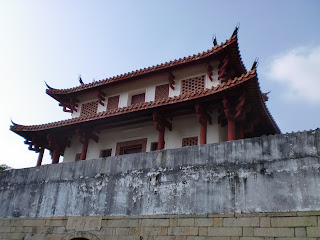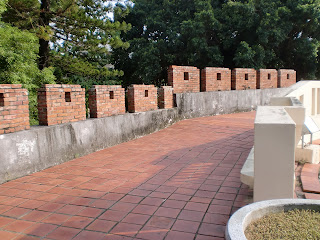I did a walking tour of a lot of Central Tainan just to the west of the train tracks the other day. I started from the train station and probably covered a good couple of miles.
My first stop was the weather station. The OLD weather station. It's in great shape, but according to the Bradt Taiwan Travel Guide, it was built by the Japanese government in 1898. That's just three years after the Japanese took control of Taiwan, and a pretty impressively old building for an island prone to earthquakes and typhoons.
此の変な建物は日本時代に作られた気象台だ。今は隣りに気象博物館も有る。残念ながら、一般人立ち入り禁止だけど、外だけ見てもちょっと納得感を得る。なんと1898年に作られたらしい!(其れ、明治30年位やろう?「明治何年」なんて凄くない?しかも、台湾の日本支配が初めてからわずかな3年目だ。)You can't go into the building, but it's still fun to look at from the outside. There's a small climate museum next door, but unless you can read Chinese, or can McGuyver it with your knowledge of Japanese, there isn't much to be gained by going. It is free though, and air-conditioned, and there are bathrooms, so maybe it is worth going. (I saw a couple of guys who, judging by how they were dressed, were engaged in construction who were sleeping on the floor in a corner of the museum. You see guys who do physical, outdoor labor like that sleeping in all sorts of places--usually on the street--in the middle of the day. It's really hot here, so mid-day naps seem to be a thing that people do. I thought these guys I saw in the museum were clever though because they had found some free air-conditioning.)
なかなか格好いい。
なんで射手座が有るのか?
次も日本時代の建物だ。1916年に作られた市役所だ。1997年まで市役所として使われたそうだ。今は「国立台湾文学館」に成っている。無料で、博物館も、図書館も有る。(本を借りて家に持ち帰る事は出来ないけど。)台湾文学だから、中国語が分からないと面白くないと思うかもしれないけど、実は英語と日本語の訳は沢山有って、文学と歴史の共通進化の話に成っているので、台湾の文学を全く知らない人でもお薦めだ。(又、無料だから、エアコンとかトイレとかが欲しがっている人にもお薦め出来る。)
This is the former Tainan City Hall. It was built by the Japanese in 1916, and was used as a government office until 1997. In a wonderful display of how to put a public building to new use, the building has been turned into the Taiwanese Museum of Literature. It's a free museum, and it has a reserve-only library located inside. Despite the subject matter making it sound like something that would only appeal to Chinese speakers, they did a good job of connecting the evolution of literature in Taiwan with its history, and most of the signs are translated into England and Japanese. This is a good museum.
I liked this big tree in the middle of the traffic circle.
ちょっと前の文字の痕が残っているね。
This is Tang De-Jhang Park. Tang was a lawyer who was killed in this very park (across the street from what was then the government office) as a result of being accused of being a separatist by the Chiang Kai-Shek Government. He was later found not-guilty after his death. (Though more importantly than him being not-guilty is the fact that his only supposed crime was a bogus political crime, and it would not have been legitimate to punish him even if he were guilty. He was part of a large number of people killed after the 228 Incident.)
「延平郡王祠」の前だ。此の人はオランダ人を台湾から出した鄭成功だ。なんか、チンギスカンに見える。
This is Zheng Chenggong, who I mentioned in a previous post. He's the son of a Chinese pirate and Japanese doctor's daughter who expelled the Dutch from Taiwan and then fought against the newly formed Qing Empire from his base in Taiwan. (Well, mostly it was his son who did the fighting. Chenggong actually died only about a year after taking over Taiwan, probably from Malaria.) Just south of the statue is a park, and a temple dedicated to Chenggong.
上記の銅像の裏に有る公園と鄭成功を祀る神社だ。
公園でオタク達はこういうフィギュアーをポーズさせて写真を撮っていた。
Taiwan's answer to the pissing boy in Belgium: A barfing dragon
Note the symbol on top of the torii. Actually, note the torii. Torii are gates that are put up in front of Shinto shrines in Japan. These were probably erected during the Japanese period when this temple was treated as a Shinto temple. Now, note the symbol on top. That's the Kuomintang's symbol. The Kuomintang (KMT) are the Chinese nationalist party, Chiang Kai-Shek's party. So what we've got here is a shrine dedicated to a pre-Qing era guy, sanctified and built by the Qing, modified by the Japanese, and then again by the Chinese Nationalists. It's most of Taiwanese history in one picture!
The Nationalist symbol is a little controversial. The south of Taiwan tends to be more pro-Taiwanese, pro-formal-independence, and anti-KMT. Because this symbol was added later, and because it is the symbol of a political party that many people in Tainan don't like much, there were calls to remove it once Taiwan democratized and ended its one-party rule by the KMT. However, calls for historical preservation won out and the symbol remains. It's a sun, by the way, and it's also on the Republic of China (Taiwan) national flag.
以上の写真はめっちゃ面白いから英語でも日本語でも同じ事を書く。鳥居に見えるだろう?其れは鳥居だからだ。日本時代に此の神社は神道の神社にさせられた。其の時に此の鳥居が付けられた。其の後、蔣介石の国民党は台湾を支配して、鳥居に国民党のシンボルが付いている。だから、此の写真一片に、清時代以前の人物を祀る、清時代に正当化されて作られた神社に、日本時代の鳥居と国民党時代の国民党シンボルが有る。台湾史は殆ど此の一片の写真に含まれている。
実は国民党のシンボルに対して、ちょっと議論が交わされた。台湾南部の方が親台湾、親正当独立派の人が多い。又、反中華国民党の人も多い。だから、台湾は国民党独占時代を終えて、今の民主主義時代に入った時点で、鳥居の上のシンボルを除こうと言う話が出た。でも、結局歴史の一部だから残すべきと言う論が勝ったから、今も有る。因みに、其のシンボルは太陽で、中華民国(台湾)の国旗にも載って有る。
シーサー!
孔子廟に似ている。同じ塀に囲まれた庭園と神社自体のスタイルだ。
This temple is very much the same style as the Confucius Temple I went to the other day. It's got a similar coloration, and the layout is the same. The main temple is in the middle of a courtyard, surrounded by walls.
I love all the little details everywhere on the structure.
An old tree outside the temple.
犬だ!神社の隣りにカフェーが有って、そこに犬がくつろいでいた。
I thought this building was pretty cool. It's just someone's house, nothing special, but I like the "melting house" look.
五妃廟の塀。
From the wall of the Five Concubines Temple.
This temple is dedicated to the five concubines of the last Ming Emperor. The emperor, realizing that he was defeated by the Qing and done for, told his wives to do as they pleased with the rest of their lives. They, in an act of loyalty, all committed suicide. They're enshrined here.
明朝の最後の天皇は敗滅を認めて、妻達に「我が死んでからご自由に」と言った。五人も忠誠を示して、自殺した。ここで祀られている。
Looks like some guy's getting a tattoo.
神社の後ろに此れが有った。偶然かもしれないけど、かなり琉球のお墓に似ていない?お墓の玄関に神社が付いていると言う感じだ。私は他のところでも琉球っぽいお墓見掛けたから、中国文化圏から其の形が伝わって来たかなと思った。
Ice truck
I realized while walking around on this day that I still didn't have any pictures of any 7-11's, which is pretty incredible. Taiwan has a greater density of 7-11's than any other country on earth. So I took this picture just so that I could say I had one.
South Gate Park
大木とおばさん。
大南門城。台南に昔14個の門が有ったらしい。都市自体は塀に囲まれた。でも日本時代に、道の工事などによって多くの門が壊された。残っている門の中で、大南門城が一番大きい。しかも、登る事も出来る。
There used to be a wall around Tainan, and there were 14 gates into the city. Japanese efforts to widen streets and modernize the city resulted in many of the gates being torn down. The most impressive of the remaining ones is the "Big South Gate". You can climb up on it too!
"Aw, honey! We've gotta call the contractor. His guys installed the cannon all wrong!"
"What's the matter?"
"It's inside the fort! What are we gonna do? Shoot our own walls? I told you we should have gone with the other guy my cousin recommended."
"You mean the one who installed the moat on our summer castle so that it ran right through our kitchen?"
"..."
中には入れない。でも夢壊したくないからいい。中は公園掃除用具の倉庫とかだったら最悪だ。
Automatic cameras do funny things when you shoot into the sun.
This is the picture I took as I fell off of the wall to the ground below. It's ok though, I just got a concussion and ok though, I just got a concussion and I ok though, I just got a concussion and walked it off.
再見し
大木まだ有る
おばさんは?
鳥がいっぱい居った。
The King in His Castle.
左側にKYの二人居る。どけろ!
I totally forgot who this guy who this plaque is for is. Sorry. It's right next to the Big South Gate.



































































































No comments:
Post a Comment